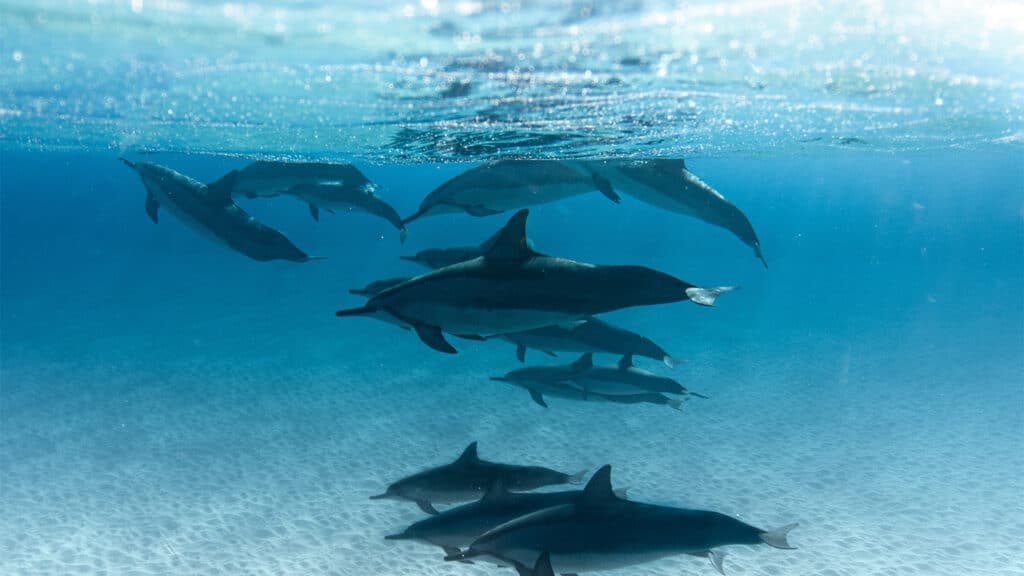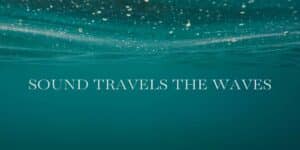Detecting and analyzing underwater noise is crucial for companies working in the maritime industry in order to monitor and reduce their carbon impact, particularly water pollution, but also to comply with international regulations. Reliable and exhaustive data are necessary for effective decision-making. While numerous articles that explain the reasons why underwater sound detection is crucial, this article rather focuses on a technical aspect, especially the material used.
What are the types of underwater sounds?
All of the time, one can hear an acoustic background called “ambient noise” under the sea. These underwater sounds are generated by various natural sources or related to human activities (“anthropogenic sounds”): breaking waves, fishes and marine animals (fishes, shrimps, mammals such as dolphins, whales…), heavy rain, natural physical processes (undersea earthquakes, cracking sea ice, and undersea volcanic activities), shipping traffic, sonars, offshore industrial activities (oil drilling and production), etc.
The sound levels are given in underwater dB. Scientists write it as “dB re 1 μPa” because sounds under the sea are measured relative (re) to a pressure of 1 microPascal (μPa) rather than the pressure of 20 μPa used as a reference to measure sounds in air.
The frequency range of sound typically varies between 10 Hz and 1 MHz. Frequencies under 10 Hz can only be detected deep into the seabed whereas the high speed of absorption of frequencies above 1 MHz makes it hardly usable. It is the main indicator used to categorize the sources of ambient noise:
- From 20 to 500 Hz: distant ships are the main cause of ambient noise. The amount of low-frequency noise is higher in areas of the world having heavy traffic on the high seas, especially in the northern hemisphere (generally 10 dB or more).
- From 500 to 100,000 Hz: breaking waves, that comes with spray and bubbles is the primary cause of mid-frequency noise. These are wind-dependent, they increase with wind speed.
- Above 100,000 Hz: it is the sound generated by the motion of water molecules (also known as “thermal noise”).
The study of the propagation of sound in water is called “underwater acoustics” or “hydroacoustic”. It has multiple purposes: fishing, sea life monitoring and protection, communication, navigation, defense, oil and gas exploration, mining, seafloor mapping, ocean and earth studies, and geological surveys. The knowledge and practical applications of acoustics are promoted by dedicated entities such as the Acoustical Society of America (ASA), the European Acoustics Association (EAA), etc.
Underwater noise assessment must be done in real-time, but specific measurements have to be carried out in specific circumstances, notably prior to potentially noisy projects in coastal zones or offshore: deployment of maritime wind farms or platforms, installation of a marine facility… Within the scope of licensing procedures, the mandatory environmental impact study (UVS) covers, among others, the analysis of the possible effects of noise emission on the marine environment during the construction, operation, and decommissioning phases.
Your environmental monitoring at your fingertips!
Optimize your environmental monitoring, become smarter and more sustainable with a unified system that gathers all your environmental sensors & data in one place.
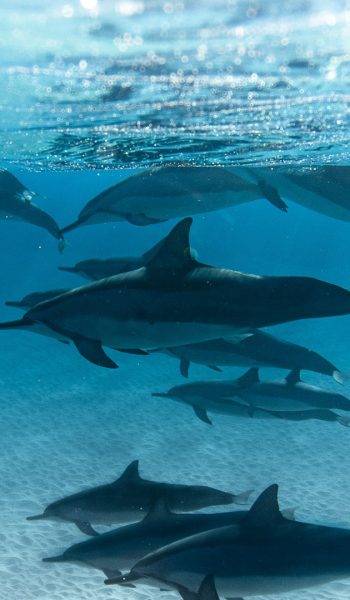
What types of equipment are used to detect sound under the sea?
Sound waves are basically similar and move similarly in water and in the air. Also, they can be characterized in the same way. However, underwater sound is harder to hear for humans because its waves travel much faster in the water than it does in the air (about 4 to 5 times at room temperature). This is due to the water density, which is far higher than air’s.
Therefore, an increasing number of underwater sound recording (USR) devices are being built and deployed worldwide to listen to the undersea sound produced by human activities and to collect data.
Hydrophone
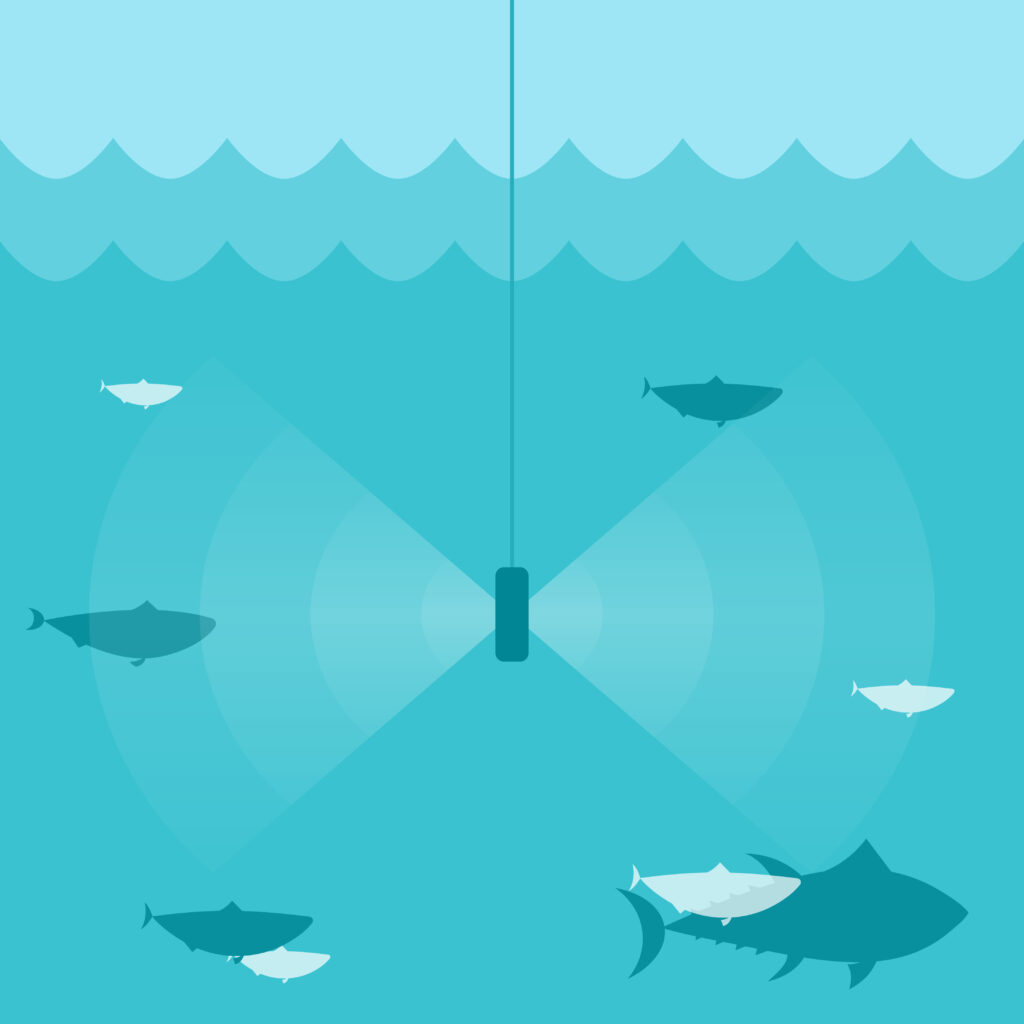
Using the principle of a microphone, a hydrophone, as its name suggests, measures sound in water – in this case, the ocean. This ultra-compact underwater device is placed on the seabed or on a floating buoy on the water’s surface, where it monitors and records sound from all directions.
A hydrophone features a piezoelectric receive-only transducer. It measures pressure variations in the surrounding environment, such as the change produced by the propagation of a sound wave. Then the transducer converts the acoustic energy into an electric charge or sound pressure level (SPL). SPL is a logarithmic measure of the mean square acoustic pressure.
Modern hydrophones can successfully detect a signal from a source that is located 3,000 miles away and can go to 1000 m (3250 ft) under the ocean’s surface, where they withstand pressures of up to 9.8 MPa. They have a high resolution and provide an omnidirectional response with remarkable accuracy in all planes at a very wide range of frequencies. They have receiving sensitivity that wan reach −180 dB and −192 dB at 1 kHz. These exceptional characteristics make them essential in the naval industry, notably for vessel and submarine tracking.
Sonar
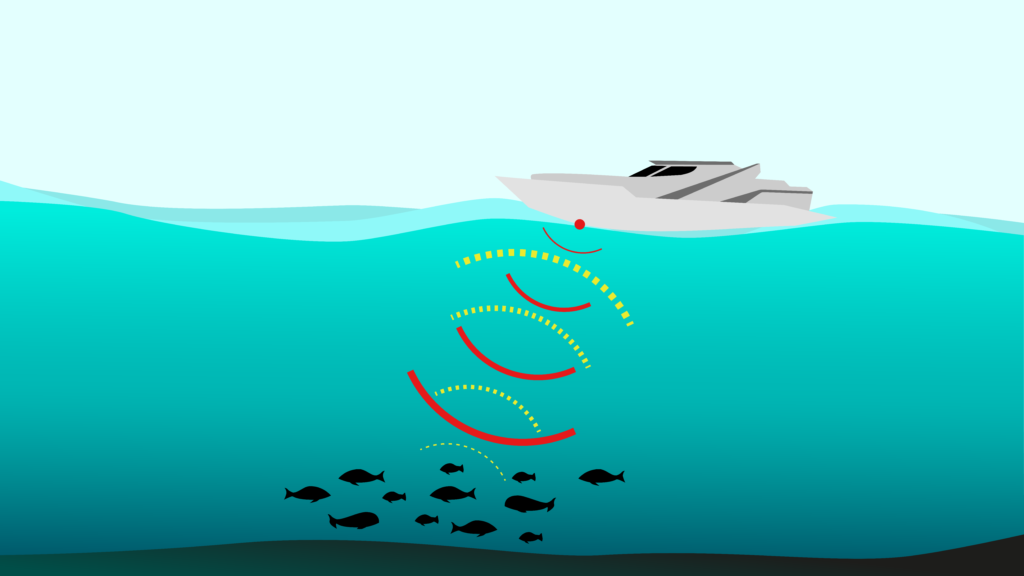
SONAR stands for “Sound Navigation and Ranging”. This technique is based on sound propagation and has several purposes:
- navigate;
- measure distances;
- identify potential hazards;
- map objects and animals under the surface of the water;
- have a profile of the ocean floor itself;
- communicate.
The term “sonar” also designates the material used to produce and receive the sound, on frequencies that vary from infrasonic to ultrasonic. It can be either active or passive:
- Active sonar
Active sonar is equipped with a sound transmitter that emits an acoustic pulse of sound (a “ping”) of a given frequency into the water. When the sound pulse hits an object on its path, the sound bounces off it. A reflection of the signal “echo” returns to the transducer’s receiver. The sonar measures the range/type of object and location, but also the distance, based on the time between the emission of the sound pulse and the reception of the echo. Research continues in order to improve the classification of the kinds of echoes and allow sonar operators or computer programs to quickly distinguish the nature of the object.
- Passive sonar
Passive sonar is only able to detect sound waves that are traveling towards it but does not emit or transmit any signal nor can measure the range of an object. It is ideal for scientists or military ships that need to be quiet and discreet. Such a system is therefore primarily used to “listen” to the ocean and detect noise from aquatic animals, vessels, and submarines. Multiple passive listening devices used together enable triangulation of a sound source.
For example, a submarine has a specific sound profile obtained by the combination of various sounds produced by its propeller, engine, and pump. Based on this unique acoustic “signature” detected by a passive system, skilled sonar operators can easily identify the kind of marine object and its relative position in shallow water.
Difference between hydrophone and sonar
A hydrophone is an unavoidable component of all passive sonar devices, allowing the latter to listen, receive the echo from any underwater object and locate it. A sonar may use a multitude of hydrophone sensors, however, not all kinds of hydrophones are used in sonar.
All equipment have to respect the IEC TS 62600-40 standard, which sets a common methodology for measuring and analyzing noise characteristics so as to ensure consistency and accuracy.
Your environmental monitoring at your fingertips!
Optimize your environmental monitoring, become smarter and more sustainable with a unified system that gathers all your environmental sensors & data in one place.

How do digital technologies impact underwater sound detection?
New digital technologies such as Artificial Intelligence, Machine Learning, and Big data allow major progress in underwater sound detection, especially in processing huge amounts of ocean acoustics data. For example, Sinay’s range of solutions comprises different modules that uses cutting-edge sensors to monitor sound and noise and transfer the data at a predefined frequency in real-time to a central dashboard. Artificial intelligence and machine learning enable the automated generation of customized reports. The aim is to have a better understanding of undersea noise and take relevant decisions to prevent negative impacts of human activities on marine species and fisheries resources, and on a wider scale, to efficiently manage their environmental impact.
Maritime sector stakeholders may also find an interest in combining this Underwater Acoustics Module with other tools developed by Sinay as marine mammals monitoring, sound recognition, aerial acoustics, and SeaLife Impact or Water Quality. An alerting system is included, which sends notifications in case the authorized thresholds are exceeded. These limits can be manually set up according to the national regulations in force.
Some software includes underwater sound recordings and audiograms of the sensitivity of marine animals that allow easy comparison to new sound sample metrics. This facilitates the evaluation of the potential acoustic impacts on marine animals (feeding, communication, social behavior, navigation, and reproduction) and the marine ecosystem as a whole.
Advanced technologies are also harnessed to improve the efficiency of listening instruments. For example, because of quieter modern diesel-electric submarines, new generations of passive sonars are now capable of measuring the motion created by sound waves, even small ones, to detect the presence of underwater targets. The U.S. Navy is already equipped with such sensors that provide them with reliable directional information.
Conclusion about How we can Detect Underwater Sound
For the shipping industry’s stakeholders, measuring and lowering underwater sounds is a great challenge. As a matter of fact, the growth of global trade (meaning greater maritime traffic) and economic activities in coastal zones lead to increasing noise pollution that threatens ocean wildlife.
In a bid to address this high-level issue, the International Maritime Organization (IMO) has provided updated guidelines to reduce the sound level due to commercial ships. These recommendations concern design (propellers, hull design, and cleaning, onboard machinery, operations, and maintenance). A main problem though is that the IMO also has to take environmental regulations into account (energy saving and greenhouse gas limitations).
Besides, setting an appropriate global regulatory framework means dealing with a huge number of species and geographical conditions (water salinity, temperature, and depth), making it difficult to apply the same rules to different locations. Meanwhile, several countries apply their own criteria to noise emissions reduction. In this regard, Canada has defined “no-go” areas on its West Coast in order to protect three types of whales that all appear in the list of endangered species.
In the coming years, digital technologies will keep on playing a vital role to develop more sophisticated sensors, in order to improve acoustical emissions assessment.
Frequently Asked Questions About How we can Detect Underwater Sound
By using materials as hydrophones or sonars.
There are different sources of underwater noise. It can be natural noise (marine mammals, fishes, rain, natural physical processes, breaking waves… But the sound can also come from human activities (anthropogenic sounds): shipping traffic, sonars, offshore industrial activities…
To monitor and reduce the carbon impact of the maritime industry, particularly water pollution, but also to comply with international regulations.

